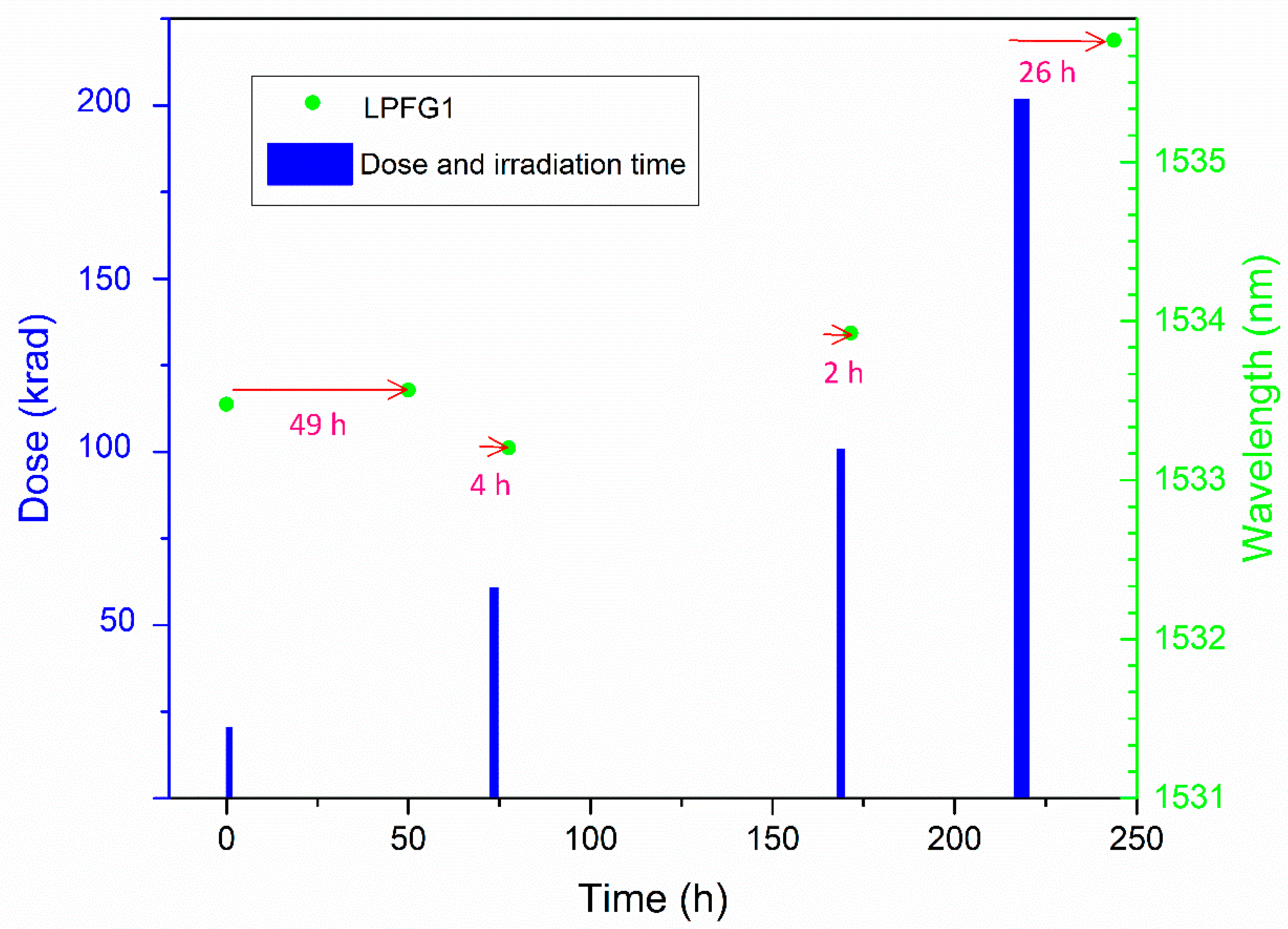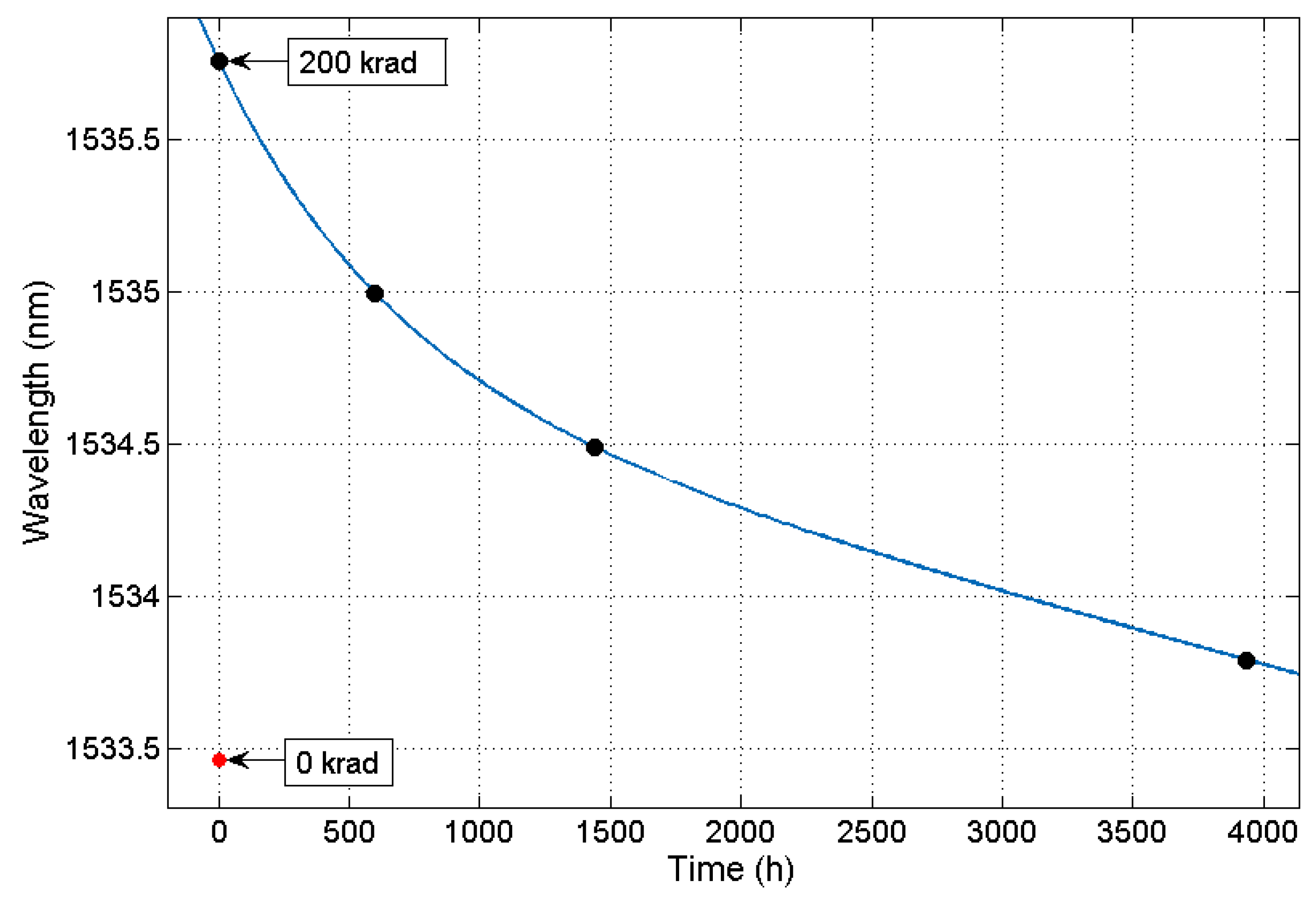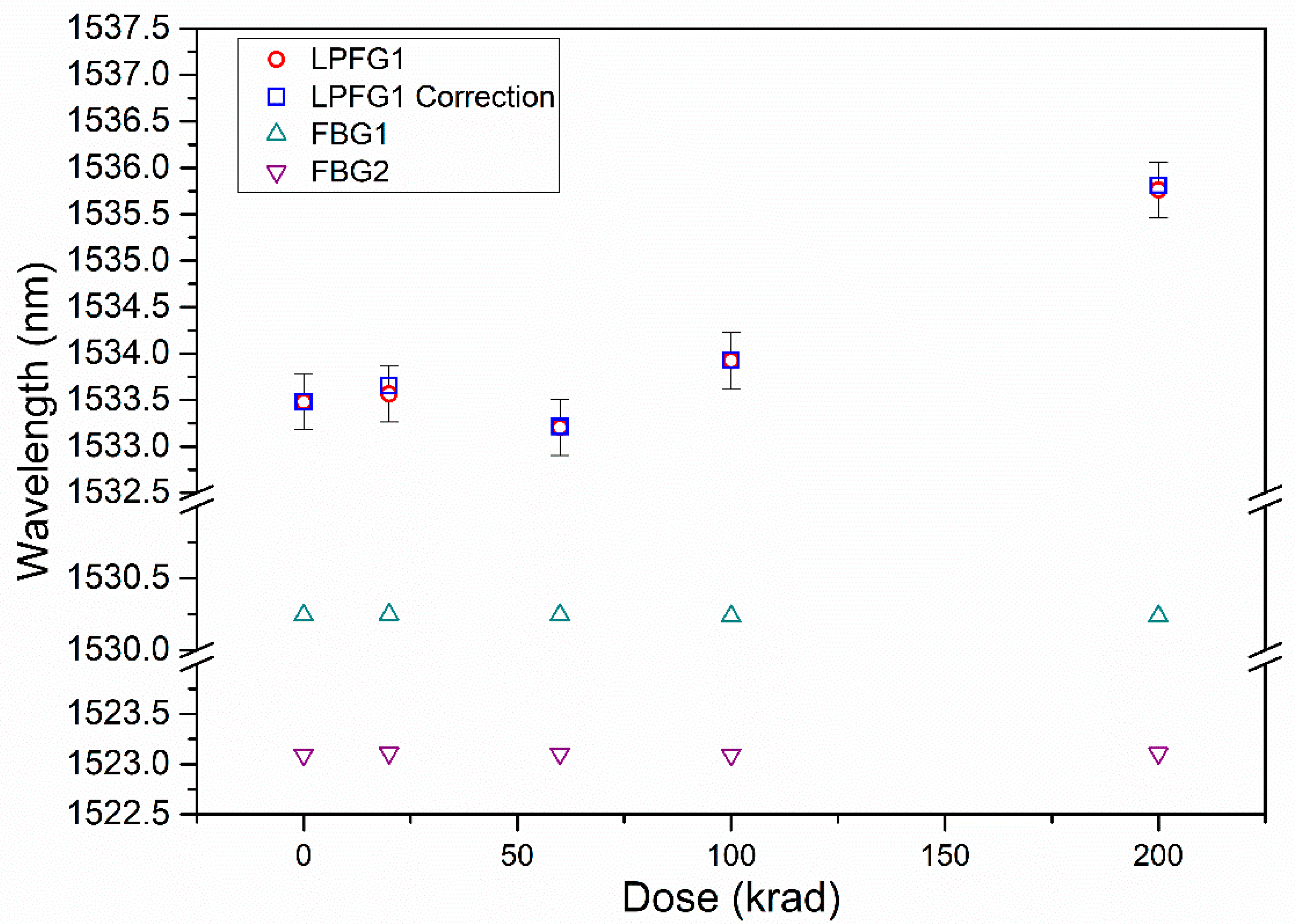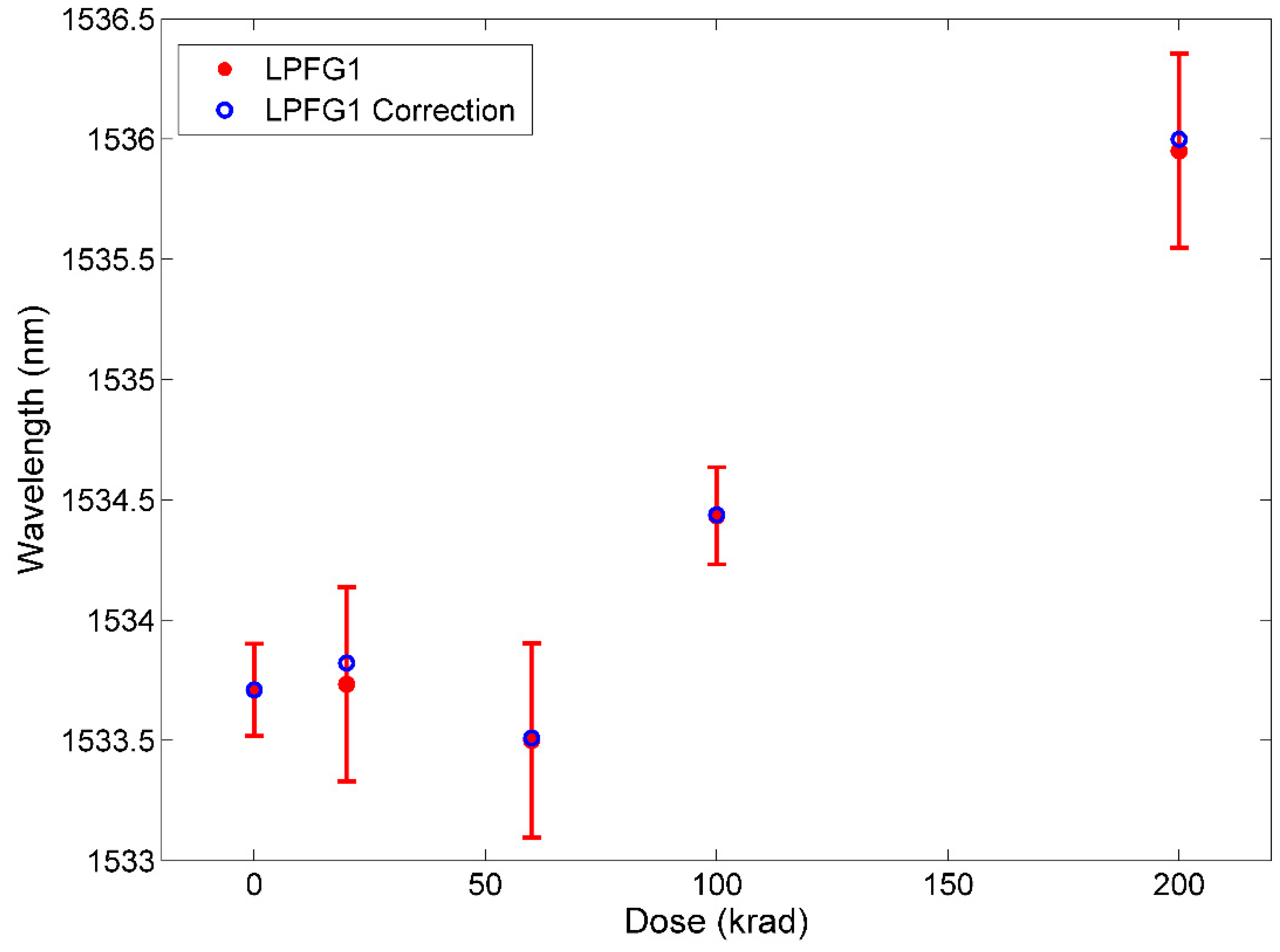Effect of Low-Doses of Gamma Radiation on Electric Arc-Induced Long Period Fiber Gratings
Abstract
:1. Introduction
2. Experimental
2.1. Samples
2.2. Gamma Irradiation Test
2.3. Optical Characterization: Repeatability
3. Results
3.1. Radiation-Induced Wavelength Shift
| Fabrication Method | Dose Rate (krad/h) | Absorbed Dose (krad) | DWS (nm) | Reference |
|---|---|---|---|---|
| CO2 | 37 | 108 and 166 | 1.1 and 1.9 | [16] |
| EAD | 18 | 200 and 600 | ~1.4 and ~3.0. | [11] |
| EAD | 20 | 500 | ~3.0 | [12] |
| EAD | 33 | 200 | 2.3 | Present work |
3.2. Temperature Sensitivity
4. Discussion and Conclusions
Author Contributions
Funding
Institutional Review Board Statement
Informed Consent Statement
Data Availability Statement
Conflicts of Interest
References
- Pevec, S.; Donlagić, D. Multiparameter Fiber-Optic Sensors: A Review. Opt. Eng. 2019, 58, 072009. [Google Scholar] [CrossRef] [Green Version]
- Grattan, K.T.V.; Sun, T. Fiber Optic Sensor Technology: An Overview. Sens. Actuators Phys. 2000, 82, 40–61. [Google Scholar] [CrossRef]
- Mihailov, S.J. Fiber Bragg Grating Sensors for Harsh Environments. Sensors 2012, 12, 1898–1918. [Google Scholar] [CrossRef]
- Mckenzie, I.; Karafolas, N. Fiber Optic Sensing in Space Structures: The Experience of the European Space Agency (Invited Paper). Proc. SPIE 2005, 5855, 262–269. [Google Scholar]
- Gusarov, A.; Leysen, W.; Wuilpart, M.; Mégret, P. Status and Future Developments of R&D on Fiber Optics Current Sensor for ITER. Fusion Eng. Des. 2018, 136, 477–480. [Google Scholar] [CrossRef]
- Kuhnhenn, J.; Weinand, U.; Morana, A.; Girard, S.; Marin, E.; Périsse, J.; Genot, J.S.; Grelin, J.; Hutter, L.; Mélin, G.; et al. Gamma Radiation Tests of Radiation-Hardened Fiber Bragg Grating-Based Sensors for Radiation Environments. IEEE Trans. Nucl. Sci. 2017, 64, 2307–2311. [Google Scholar] [CrossRef]
- Heredero, R.L.; Frövel, M.; Laguna, H.; Belenguer, T. In-Orbit Demonstration of Fiber Optic Sensors Based on Bragg Gratings. In Proceedings of the International Conference on Space Optics—ICSO 2018; International Society for Optics and Photonics: Chania, Greece, 2019; Volume 11180, p. 111807D. [Google Scholar]
- Esposito, F.; Srivastava, A.; Campopiano, S.; Iadicicco, A. Radiation Effects on Long Period Fiber Gratings: A Review. Sensors 2020, 20, 2729. [Google Scholar] [CrossRef]
- Gusarov, A.; Hoeffgen, S.K. Radiation Effects on Fiber Gratings. IEEE Trans. Nucl. Sci. 2013, 60, 2037–2053. [Google Scholar] [CrossRef]
- Henschel, H.; Hoeffgen, S.K.; Krebber, K.; Kuhnhenn, J.; Weinand, U. Influence of Fiber Composition and Grating Fabrication on the Radiation Sensitivity of Fiber Bragg Gratings. In Proceedings of the 2007 9th European Conference on Radiation and Its Effects on Components and Systems, Deauville, France, 10–14 September 2007; pp. 1–8. [Google Scholar]
- Esposito, F.; Ranjan, R.; Stăncălie, A.; Sporea, D.; Neguţ, D.; Becherescu, N.; Campopiano, S.; Iadicicco, A. Real-Time Analysis of Arc-Induced Long Period Gratings under Gamma Irradiation. Sci. Rep. 2017, 7, 1–9. [Google Scholar] [CrossRef] [Green Version]
- Esposito, F.; Stăncălie, A.; Neguţ, C.-D.; Campopiano, S.; Sporea, D.; Iadicicco, A. Comparative Investigation of Gamma Radiation Effects on Long Period Gratings and Optical Power in Different Optical Fibers. J. Light. Technol. 2019, 37, 4560–4566. [Google Scholar] [CrossRef]
- Stancălie, A.; Esposito, F.; Ranjan, R.; Bleotu, P.; Campopiano, S.; Iadicicco, A.; Sporea, D. Arc-Induced Long Period Gratings in Standard and Speciality Optical Fibers under Mixed Neutron-Gamma Irradiation. Sci. Rep. 2017, 7, 15845. [Google Scholar] [CrossRef] [Green Version]
- Rego, G.; Fernandez, A.F.; Gusarov, A.; Brichard, B.; Berghmans, F.; Santos, J.L.; Salgado, H.M. Effect of Ionizing Radiation on the Properties of Arc-Induced Long-Period Fiber Gratings. Appl. Opt. 2005, 44, 6258–6263. [Google Scholar] [CrossRef] [Green Version]
- Sporea, D.; Stancalie, A.; Negut¸, D.; Pilorget, G.; Delepine-Lesoille, S.; Lablonde, L. Online Tests of an Optical Fiber Long-Period Grating Subjected to Gamma Irradiation. IEEE Photon. J. 2014, 6, 1–9. [Google Scholar] [CrossRef]
- Sporea, D.; Stăncalie, A.; Neguţ, D.; Pilorget, G.; Delepine-Lesoille, S.; Lablonde, L. Comparative Study of Long Period and Fiber Bragg Gratings under Gamma Irradiation. Sens. Actuators Phys. 2015, 233, 295–301. [Google Scholar] [CrossRef]
- Stephen, W. James Ralph, P. Tatam Optical Fibre Long-Period Grating Sensors: Characteristics and Application. Meas. Sci. Technol. 2003, 14, R49–R61. [Google Scholar]
- Rego, G. A Review of Refractometric Sensors Based on Long Period Fibre Gratings. Sci. World J. 2013, 2013, 1–14. [Google Scholar] [CrossRef] [Green Version]
- Bhatia, V.; Ashish, M. Vengsarkar Optical Fiber Long-Period Grating Sensors. Opt. Lett. 1996, 21, 692–694. [Google Scholar] [CrossRef]
- Jorge, P.A.S.; Silva, S.O.; Gouveia, C.; Tafulo, P.; Coelho, L.; Caldas, P.; Viegas, D.; Rego, G.; Baptista, J.M.; Santos, J.L.; et al. Fiber Optic-Based Refractive Index Sensing at INESC Porto. Sensors 2012, 12, 8371–8389. [Google Scholar] [CrossRef] [PubMed] [Green Version]
- Rego, G. Arc-Induced Long Period Fiber Gratings. J. Sens. 2016, 2016, e3598634. [Google Scholar] [CrossRef] [Green Version]
- Iadicicco, A.; Ranjan, R.; Campopiano, S. Fabrication and Characterization of Long-Period Gratings in Hollow Core Fibers by Electric Arc Discharge. IEEE Sens. J. 2015, 15, 3014–3020. [Google Scholar] [CrossRef]
- Coelho, J.M.P.; Silva, C.; Nespereira, M.; Abreu, M.; Rebordão, J. Writing of Long Period Fiber Gratings Using CO2 Laser Radiation. In Advances in Optical Fiber Technology: Fundamental Optical Phenomena and Applications; Yasin, M.O.H., Arof, H., Harun, S.W., Eds.; InTech: Rijeka, Croatia, 2015; ISBN 978-953-51-1742-1. [Google Scholar]
- Viveiros, D.; de Almeida, J.M.M.M.; Coelho, L.; Vasconcelos, H.; Amorim, V.A.; Maia, J.M.; Jorge, P.A.S. Spectral Tuning of Long Period Fiber Gratings Fabricated by Femtosecond Laser Micromachining through Thermal Annealing. Multidiscip. Digit. Publ. Inst. Proc. 2019, 15, 4. [Google Scholar] [CrossRef] [Green Version]
- Poveda-Wong, L.; Cruz, J.L.; Delgado-Pinar, M.; Roselló-Mechó, X.; Díez, A.; Andrés, M.V. Fabrication of Long Period Fiber Gratings of Subnanometric Bandwidth. Opt. Lett. 2017, 42, 1265. [Google Scholar] [CrossRef] [Green Version]
- Fairén, A.G.; Gómez-Elvira, J.; Briones, C.; Prieto-Ballesteros, O.; Rodríguez-Manfredi, J.A.; López Heredero, R.; Belenguer, T.; Moral, A.G.; Moreno-Paz, M.; Parro, V. The Complex Molecules Detector (CMOLD): A Fluidic-Based Instrument Suite to Search for (Bio)Chemical Complexity on Mars and Icy Moons. Astrobiology 2020, 20, 1076–1096. [Google Scholar] [CrossRef] [PubMed]
- ESA-Star Publication. Available online: https://esastar-publication-ext.sso.esa.int/ESATenderActions (accessed on 27 February 2020).
- ESA-star Publication. Available online: https://esastar-publication-ext.sso.esa.int/ESATenderActions/details/7466 (accessed on 30 October 2020).
- Heredero, R.L.; Uribe-Patarroyo, N.; Belenguer, T.; Ramos, G.; Sánchez, A.; Reina, M.; Pillet, V.M.; Álvarez-Herrero, A. Liquid-Crystal Variable Retarders for Aerospace Polarimetry Applications. Appl. Opt. 2007, 46, 689–698. [Google Scholar] [CrossRef] [PubMed]
- Parejo, P.G.; Álvarez-Herrero, A. Liquid Crystals for Space Instrumentation: Optical Properties of Liquid Crystal Mixtures for Polarimeters. Opt. Mater. Express 2019, 9, 2681–2698. [Google Scholar] [CrossRef]
- Coelho, L.; Santos, J.L.; Viegas, D.; Almeida, J.M.M.M. de Fabrication and Characterization of Metal Oxide-Coated Long-Period Fiber Gratings. J. Light. Technol. 2016, 34, 2533–2539. [Google Scholar] [CrossRef]









| Parameter | Standard DeviationLPFG1 (nm) | Standard Deviation LPFG2 (nm) | Standard Deviation Control LPFG (nm) |
|---|---|---|---|
| Temperature | 0.02 | 0.03 | 0.01 |
| Connectors | 0.07 | 0.09 | 0.09 |
| Weight | 0.3 | 0.1 | 0.09 |
| Setup | --- | --- | 0.08 |
Publisher’s Note: MDPI stays neutral with regard to jurisdictional claims in published maps and institutional affiliations. |
© 2021 by the authors. Licensee MDPI, Basel, Switzerland. This article is an open access article distributed under the terms and conditions of the Creative Commons Attribution (CC BY) license (http://creativecommons.org/licenses/by/4.0/).
Share and Cite
Mesonero-Santos, P.; Fernández-Medina, A.; Coelho, L.C.C.; Viveiros, D.; Jorge, P.A.; Belenguer, T.; López Heredero, R. Effect of Low-Doses of Gamma Radiation on Electric Arc-Induced Long Period Fiber Gratings. Sensors 2021, 21, 2318. https://doi.org/10.3390/s21072318
Mesonero-Santos P, Fernández-Medina A, Coelho LCC, Viveiros D, Jorge PA, Belenguer T, López Heredero R. Effect of Low-Doses of Gamma Radiation on Electric Arc-Induced Long Period Fiber Gratings. Sensors. 2021; 21(7):2318. https://doi.org/10.3390/s21072318
Chicago/Turabian StyleMesonero-Santos, Patricia, Ana Fernández-Medina, Luis C. C. Coelho, Duarte Viveiros, Pedro A. Jorge, Tomás Belenguer, and Raquel López Heredero. 2021. "Effect of Low-Doses of Gamma Radiation on Electric Arc-Induced Long Period Fiber Gratings" Sensors 21, no. 7: 2318. https://doi.org/10.3390/s21072318









